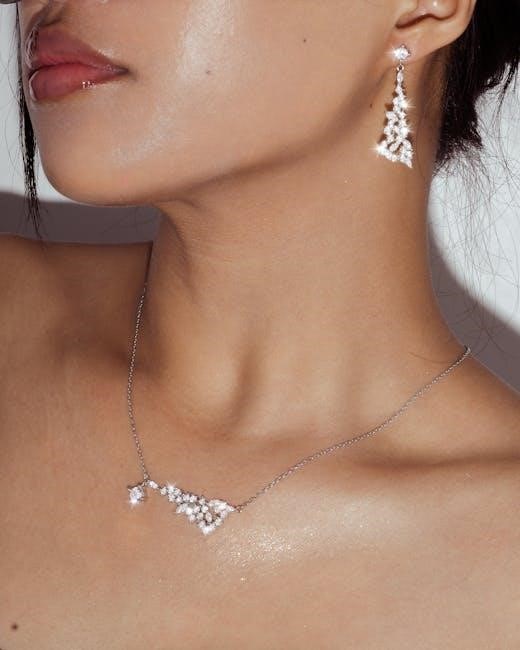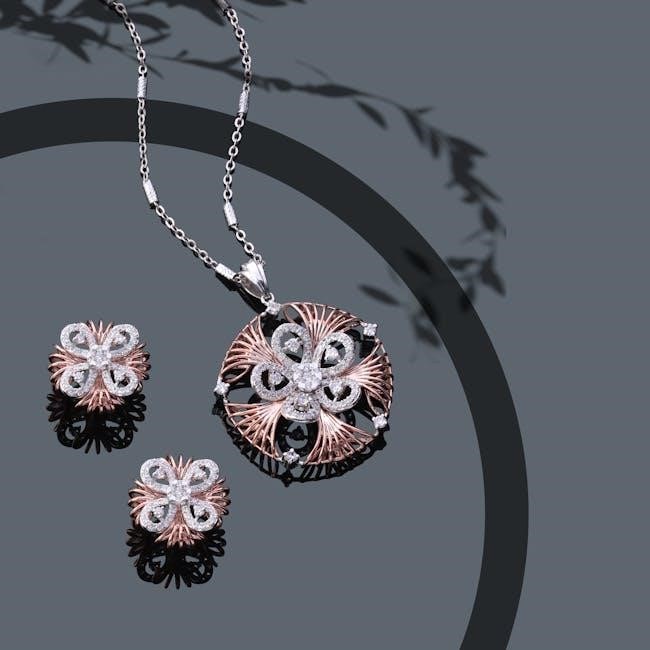Guy de Maupassant’s “The Diamond Necklace” (1884) is a timeless short story exploring themes of greed, social class, and illusion, renowned for its iconic twist ending.
1.1 Background and Historical Context
Guy de Maupassant’s “The Diamond Necklace” was published in 1884, set in late 19th-century Paris. It reflects the social stratification and economic struggles of the time, focusing on the middle class’s pursuit of luxury and the contrasts between poverty and wealth. Maupassant’s realistic style captures the aspirations and despair of his characters, mirroring the societal tensions of his era.
1.2 The Twist Ending: A Hallmark of Maupassant’s Style
Guy de Maupassant’s “The Diamond Necklace” famously features a twist ending, a signature element of his writing. The revelation that the necklace was a fake shocks readers, underscoring themes of illusion, greed, and fate. This unexpected conclusion masterfully highlights the irony of life and the devastating consequences of ambition, leaving a lasting impact on readers and solidifying the story’s memorable legacy.

Plot Summary of “The Diamond Necklace”
“The Diamond Necklace” tells the story of Madame Loisel, a woman consumed by desire for luxury, who borrows a diamond necklace for a ball, loses it, and endures years of hardship to replace it, only to discover the necklace was a fake.
2.1 The Life of Madame Loisel
Madame Loisel, a beautiful and ambitious woman, feels trapped in her modest life as the wife of a low-ranking clerk. She longs for luxury and admiration, often fantasizing about a more affluent lifestyle. Her dissatisfaction with her humble surroundings and lack of fine possessions fuels her desire to attend high-society events, setting the stage for her fateful decision to borrow the diamond necklace.
2.2 The Ministry Invitation and the Borrowed Necklace
When Monsieur Loisel brings home an invitation to a prestigious Ministry ball, Madame Loisel is distraught, feeling she has nothing suitable to wear. Her husband suggests borrowing jewelry from her wealthy friend, Madame Forestier. She reluctantly agrees and selects a stunning diamond necklace, which she adorns for the ball, unaware of the devastating consequences this decision will bring.
2.3 The Night of the Ball and the Loss of the Necklace
At the ball, Madame Loisel captivates everyone with her beauty and the dazzling necklace. However, in her haste to leave, she loses the necklace. Frantic, the couple searches but finds nothing. Unaware it’s a fake, they resort to desperate measures, borrowing money to replace it, leading to years of financial struggle and personal hardship, forever changing their lives.
Major Themes in “The Diamond Necklace”
The story explores themes of greed, vanity, and social class, highlighting the struggle between appearance and reality, and the destructive nature of desire.
3.1 The Struggle Between Appearance and Reality
In “The Diamond Necklace,” Maupassant vividly portrays the tension between appearance and reality through Madame Loisel’s relentless pursuit of luxury. Her obsession with projecting a wealthy image contrasts sharply with her modest life, illustrating how societal pressures often distort self-perception and lead to chasing illusions over true happiness.
3.2 The Consequences of Greed and Vanity
Madame Loisel’s insatiable desire for luxury and her inability to accept her modest life lead to a tragic downfall. Her greed for the diamond necklace results in a decade of poverty and hardship, highlighting the devastating consequences of prioritizing materialism over true happiness and the fleeting nature of vanity-driven aspirations.
3.3 Social Class and the Pursuit of Luxury
The story vividly portrays the rigid social stratification of 19th-century France, where luxury symbolizes status. Madame Loisel’s obsession with luxury reflects her longing to transcend her lower-class existence, while the ball represents a temporary escape into an elite world, underscoring the societal pressures that drive individuals to pursue unattainable lifestyles and the illusion of upward mobility.
Character Analysis
The story revolves around Madame Loisel, a woman consumed by her desire for luxury, her practical husband Monsieur Loisel, and Madame Forestier, the wealthy friend whose kindness sets off a chain of events.
4.1 Madame Loisel: A Victim of Her Desires
Madame Loisel, a young woman from a humble background, is consumed by her desire for luxury and social status. Her obsession with wealth and beauty leads her to borrow a diamond necklace, setting off a chain of events that defines her fate. Her inability to accept her circumstances and her covetous nature ultimately lead to her downfall, making her a tragic figure in the story.
4.2 Monsieur Loisel: The Voice of Reason
Monsieur Loisel, a simple clerk, represents practicality and moderation. He tries to satisfy his wife’s desires within their means, offering rational solutions. However, his efforts are overshadowed by Madame Loisel’s relentless pursuit of luxury, highlighting the contrast between his sensible nature and her unrealistic ambitions, which ultimately lead to their financial ruin.
4.3 Madame Forestier: The Symbol of Wealth and Generosity
Madame Forestier embodies wealth and kindness, offering Madame Loisel the diamond necklace. Her generosity highlights the contrast between her luxurious life and Madame Loisel’s modest existence. The necklace, a symbol of status, is lent freely, showcasing Madame Forestier’s charitable nature. However, the loss of the necklace triggers a chain of tragic events, underscoring the irony of her well-intentioned gesture.
Setting and Atmosphere
The story is set in late 19th-century Paris, contrasting the Loisel’s humble home with the opulent Ministry ball, creating a stark atmosphere of poverty and luxury.
5.1 Paris in the Late 19th Century
Paris in the late 19th century was a city of stark contrasts, where opulent luxury and grinding poverty coexisted. The story unfolds against this backdrop, highlighting the social stratification and economic disparities of the time. The Loisel’s modest home and the grand Ministry ball illustrate the city’s dual worlds, where wealth and deprivation were starkly evident in both environments and societal expectations.
5.2 The Contrasting Worlds of Poverty and Luxury
The story vividly portrays the stark contrast between the worlds of poverty and luxury in 19th-century Paris. Madame Loisel’s humble home, with its worn furniture and plain decor, stands in stark contrast to the opulent Ministry ball, where wealth and status reign supreme. This duality underscores the societal divide and the longing for upward mobility that drives the narrative’s tragic events forward with unrelenting force.
Symbolism in “The Diamond Necklace”
The diamond necklace symbolizes luxury and social status, while the ball represents fleeting happiness. These elements highlight the illusion of upward mobility and the cost of ambition.
6.1 The Necklace as a Symbol of Unattainable Luxury
The diamond necklace embodies the elusive luxury Madame Loisel yearns for, symbolizing the unattainable wealth and status she covets. Its glittering beauty contrasts sharply with her modest life, representing the social divide she desperately wants to bridge. The necklace’s allure triggers her quest for upward mobility, leading to a chain of events that ultimately underscores the cost of chasing unattainable dreams.
6.2 The Ball: A Moment of Illusionary Happiness
The ball represents a fleeting moment of joy and illusion for Madame Loisel, where she transcends her mundane life. Adorned with the necklace, she captivates the elite, basking in admiration and luxury. This night becomes her pinnacle of happiness, a temporary escape from reality, but it also sets the stage for the tragic consequences of her desires.

Moral and Philosophical Reflections
The story reflects on the consequences of deception and the irony of life, teaching that true happiness lies in honesty and contentment, not illusion or greed.
7.1 The Irony of Life and the Price of Ambition
The story highlights life’s irony through Madame Loisel’s ambition. Her pursuit of luxury leads to a decade of hardship, as she and her husband struggle to replace the lost necklace. The financial burden and loss of youth underscore the futility of materialism. The tragic realization that the necklace was fake intensifies the narrative’s poignant reflection on ambition’s cost.
7.2 The Tragic Consequences of Deception
Madame Loisel’s deception leads to irreversible consequences, as her lies about the necklace’s loss trap her in a cycle of debt and hardship. The family’s decade-long struggle to repay the debt destroys their youth and happiness, underscored by the poignant irony that the necklace was fake. This underscores the destructive power of deception and the futility of chasing illusions.

Historical and Literary Significance
Published in 1884, Guy de Maupassant’s “The Diamond Necklace” is a classic of French realist literature, influencing literary movements and remaining a popular educational resource.
8.1 Maupassant’s Influence on Short Story Writing
Guy de Maupassant’s “The Diamond Necklace” showcased his mastery of the short story form, emphasizing concise narratives and unexpected endings. His work influenced literary movements, inspiring writers to adopt realistic storytelling and psychological depth. Maupassant’s ability to craft relatable characters and moral dilemmas solidified his legacy, making him a foundational figure in modern short story writing.
8.2 The Story’s Impact on Literary Movements
“The Diamond Necklace” significantly influenced literary movements, particularly Realism and Naturalism, by focusing on the struggles of middle-class life. Its concise structure and twist ending inspired writers to adopt similar techniques, shaping the development of short story narratives in 19th-century literature and beyond.

Critical Reception and Reviews
“The Diamond Necklace” has received widespread acclaim for its concise style and profound exploration of human flaws. Critics praise its timeless appeal and enduring relevance to literary analysts.
9.1 Contemporary Reviews and Praise
“The Diamond Necklace” captivated 19th-century readers with its poignant portrayal of societal pressures. Critics lauded Maupassant’s ability to weave a tale that exposed the fragility of human ambition through Madame Loisel’s tragic journey. The story’s twist ending was hailed as revolutionary, enhancing its acclaim. Reviewers celebrated its concise yet powerful narrative, solidifying its place as a timeless literary masterpiece, resonating across generations.
9.2 Modern Interpretations and Analysis
Modern scholars praise “The Diamond Necklace” for its enduring relevance, exploring themes like materialism and social illusion. The twist ending is celebrated for its psychological depth, while Madame Loisel’s character sparks feminist debates about societal expectations. Contemporary readers appreciate its concise yet profound commentary on human nature, making it a timeless cultural critique with universal appeal.
Comparison with Other Works by Maupassant
Much like “Boule de Suif,” “The Diamond Necklace” showcases Maupassant’s mastery of irony and twist endings, exploring themes of societal illusion and human frailty with profound insight.
10.1 Similar Themes in “Boule de Suif” and “The Necklace”
Both “Boule de Suif” and “The Diamond Necklace” explore themes of societal illusion, human frailty, and the struggle between appearance and reality. Maupassant critiques social hierarchies through strong female protagonists, highlighting their emotional and psychological struggles. Both stories use irony and twist endings to underscore the consequences of human ambition and the fragility of social status, resonating with universal human experiences.
10.2 Maupassant’s Use of Irony and Twist Endings
Guy de Maupassant masterfully employs irony and twist endings to captivate readers. In “The Diamond Necklace,” the revelation that the necklace was fake is a striking example of situational irony, underscoring the futility of the Loisels’ decade-long struggle. This technique, common in his works, enhances the emotional impact and reinforces themes of greed and the illusion of luxury.

Educational Significance and Study Guides
“The Diamond Necklace” is widely used in literature classes, offering insights into themes like greed and social class. Its moral lessons make it a valuable educational resource.
11.1 The Story’s Use in Literature Classes
“The Diamond Necklace” is widely taught in literature classes for its exploration of themes like greed, social class, and illusion. Its concise structure and moral depth make it ideal for analyzing narrative techniques, character development, and the consequences of human folly. The story is often included in anthologies and study guides, providing rich material for essays and discussions on ethical dilemmas and societal pressures.
11.2 Key Discussion Points for Students
- The moral implications of Madame Loisel’s choices and the consequences of her actions.
- The symbolism of the necklace as a representation of unattainable luxury and desire.
- How social class and societal expectations influence characters’ decisions.
- The psychological impact of deception and the irony of the twist ending.

Adaptations and Interpretations in Media
“The Diamond Necklace” has been adapted into films, plays, and TV series, highlighting its timeless themes and twist ending, while modern interpretations offer fresh perspectives on Maupassant’s classic tale;
12.1 Film and Stage Adaptations
“The Diamond Necklace” has been adapted into numerous films, plays, and TV productions, including a 1959 film and a 1999 TV movie. Stage adaptations emphasize the story’s dramatic twist, while modern interpretations explore its timeless themes of greed and illusion, staying true to Maupassant’s original narrative.
12.2 Modern Retellings and Inspired Works
Modern adaptations of “The Diamond Necklace” include reinterpretations in literature, film, and even digital media, offering fresh perspectives on its timeless themes. Inspired works often explore contemporary contexts, such as social media obsessions or financial struggles, while maintaining the core message of ambition and illusion that defines Maupassant’s original tale.
Guy de Maupassant’s “The Diamond Necklace” remains timeless, offering a poignant lesson on greed’s consequences. Its enduring appeal ensures its continued relevance in modern literature studies and reflections.
13.1 The Timeless Appeal of “The Diamond Necklace”
Guy de Maupassant’s “The Diamond Necklace” endures as a timeless tale due to its universal themes of ambition, greed, and the human condition. Its masterful twist and poignant moral resonate across generations, making it a cornerstone of literary study and reflection, ensuring its continued relevance in contemporary discussions of social class and personal aspiration.
13.2 The Story’s Relevance in Contemporary Society
The tale’s themes of social ambition, materialism, and illusion remain strikingly relevant today. In an era dominated by social media and consumerism, the pressure to project wealth and status resonates deeply. The story serves as a cautionary tale about the consequences of chasing unattainable luxury and the enduring struggle between appearance and reality in modern life.
